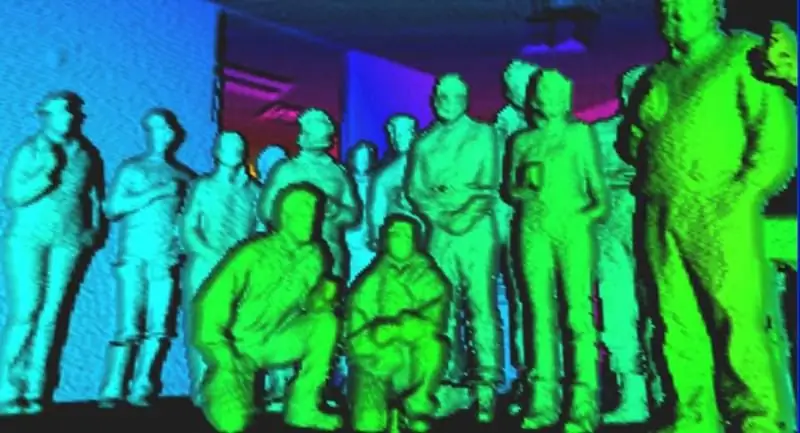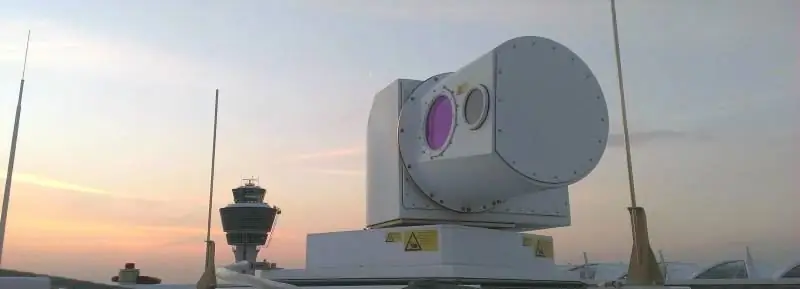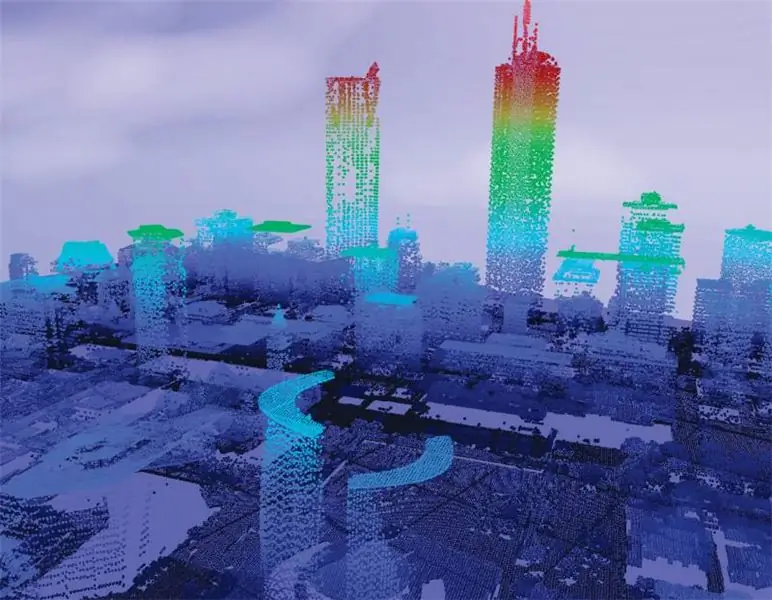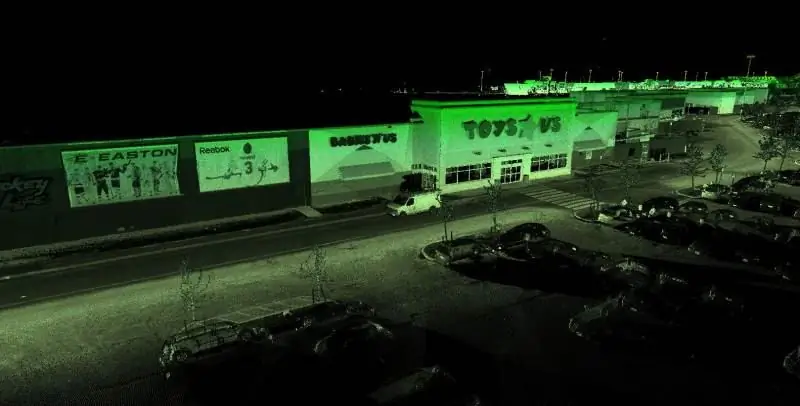- Author Matthew Elmers [email protected].
- Public 2023-12-16 21:49.
- Last modified 2025-01-24 09:17.

As a concept, lidar has been around for decades. However, interest in this technology has grown sharply in recent years, as sensors become smaller, more complex, and the scope of products with lidar technology is expanding more and more.
The word lidar is a transliteration of LIDAR (Light Detection and Ranging). This is a technology for obtaining and processing information about distant objects using active optical systems that use the phenomena of light reflection and scattering in transparent and semitransparent media. Lidar as a device is similar to a radar, therefore its application is observation and detection, but instead of radio waves, as in a radar, it uses light generated in the overwhelming majority of cases by a laser. The term lidar is often used interchangeably with the term ladar, which stands for laser detection and ranging, although Joe Buck, head of research at Coherent Technologies, part of Lockheed Martin's space systems division, said the two concepts are from technical point of view are different. “When you look at something that might be considered a soft object, such as particulate matter or an aerosol in the air, experts tend to use lidar when talking about detecting these objects. When you look at solid, solid objects like a car or a tree, then you tend to lean towards the term Ladar. " For a little more information on lidar from a scientific point of view, see the section "Lidar: How It Works".
“Lidar has been the subject of research for many decades since its inception in the early 1960s,” Buck continued. However, interest in it has grown noticeably since the beginning of this century, thanks, first of all, to technological progress. He used synthetic aperture rendering as an example. The larger the telescope, the higher the resolution of the object can be obtained. If you need extremely high resolution, then a much larger optical system may be needed, which may not be very practical from a practical point of view. Synthetic aperture imaging solves this problem by using a moving platform and signal processing to obtain an actual aperture that can be much larger than the physical aperture. Synthetic aperture radars (SARs) have been in use for many decades. However, it was not until the early 2000s that practical demonstrations of synthetic aperture optical imaging began, despite the fact that lasers were already widely used at the time. “In fact, it took more time to develop optical sources that would have sufficient stability over a wide range of adjustment … The improvement of materials, light sources and detectors (used in lidars) continues. Not only do you now have the ability to take these measurements, you are able to do them in small blocks, making the systems practical in terms of size, weight and power consumption."

It also becomes easier and more practical to collect data from the lidar (or information collected by the lidar). Traditionally, it has been assembled from aircraft sensors, says Nick Rosengarten, head of the Geospatial Exploitation Products Group at BAE Systems. However, today, sensors can be installed in ground vehicles or even in backpacks, which implies human data collection. “This opens up a whole host of possibilities, data can now be collected both indoors and outdoors,” explained Rosengarten. Matt Morris, Head of Geospatial Solutions at Textron Systems, says “The lidar is a truly amazing dataset because it provides the most detailed detail on the Earth's surface. It gives a much more detailed and, so to speak, more tinted image than DTED (Digital Terrain Elevation Data) technology, which provides information about the height of the earth's surface at certain points. Perhaps one of the most powerful use cases I've heard from our military customers is the scenario of deploying in unfamiliar terrain, because they need to know where they are going to go … to climb a roof or climb a fence. The DTED data does not allow you to see this. You won't even see the buildings."
Morris noted that even some traditional high-resolution terrain elevation data will not allow you to see these features. But the lidar allows you to do this because of its "position spacing" - a term describing the distance between positions that can be accurately shown in the data array. In the case of a lidar, the “pitch” can be reduced to centimeters, “so you can know exactly the height of the roof of a building or the height of a wall or the height of a tree. This really increases the level of three-dimensional (3D) situational awareness. " In addition, the cost of lidar sensors is decreasing, as is their size, making them more affordable. “Ten years ago, lidar sensor systems were very large and very expensive. They really had high power consumption. But as they evolved, technologies improved, platforms became much smaller, energy consumption decreased, and the quality of the data they generated increased."


Morris said that the main use of the lidar in the military field is in 3D planning and training of combat missions. For example, his company's Lidar Analyst flight simulation product allows users to take in large amounts of data and "quickly generate these 3D models, then they can plan their missions very accurately." The same is true for ground operations. Morris explained: "Our product is used to plan entry and exit routes to the target area, and since the raw data is high resolution, it is possible to conduct very accurate analysis of the situation within the line of sight."
Along with Lidar Analyst, Textron has developed RemoteView, an image analysis software product for the US military and intelligence agencies. RemoteView software can use a variety of data sources, including lidar data. BAE Systems also provides software for geospatial analysis, its flagship product here is SOCET GXP, which provides many capabilities, including the use of lidar data. In addition, Rosengarten explained that the company has developed the GXP Xplorer technology, which is a data management application. These technologies are quite suitable for military applications. Rosengarten, for example, mentioned a tool for calculating the helicopter landing zone that is part of the SOCET GXP software. "It can take lidar data and provide users with information about areas on the ground that may be sufficient for a helicopter to land." For example, he can tell them if there are vertical obstacles in the way, such as trees: "People can use this tool to identify areas that might be best suited as an evacuation point during humanitarian crises." Rosengarten also highlighted the potential of tiling, where multiple lidar datasets are collected from a specific area and stitched together. This is made possible by “the increased fidelity of lidar sensor metadata in combination with software such as BAE Systems' SOCET GXP application, which can turn metadata into precise zones on the ground, calculated using geospatial data. The process is based on lidar data and does not depend on how the data is collected."

How it works: lidar
Lidar works by illuminating the target with light. The lidar can use light in the visible, ultraviolet or near infrared ranges. The principle of operation of the lidar is simple. The object (surface) is illuminated with a short light pulse, the time after which the signal returns to the source is measured. Lidar launches fast short pulses of laser radiation onto an object (surface) with a frequency of up to 150,000 pulses per second. A sensor on the device measures the time between the transmission of a light pulse and its reflection, based on a constant light speed of 299792 km / s. By measuring this time interval, it is possible to calculate the distance between the lidar and a separate part of the object and, therefore, build an image of the object based on its position relative to the lidar.
Wind shear
Meanwhile, Buck pointed to possible military applications of Lockheed Martin's WindTracer technology. The commercial technology WindTracer uses lidar to measure wind shear at airports. The same process can be used in the military field, for example, for precision airdrops. “You need to drop supplies from a high enough height, for this you put them on pallets and drop them from a parachute. Now let's see where they land? You can try and predict where they will go, but the problem is that as you descend, the wind shear changes direction at different altitudes,”he explained. - And then how do you predict where the pallet will land? If you can measure the wind and optimize the trajectory, then you can deliver supplies with very high accuracy.”
Lidar is also used in unmanned ground vehicles. For example, the manufacturer of automatic ground vehicles (AHAs), Roboteam, has created a tool called Top Layer. It is a 3D mapping and autonomous navigation technology that uses lidar. Top Layer uses lidar in two ways, says Shahar Abukhazira, head of Roboteam. The first allows real-time mapping of enclosed spaces. “Sometimes the video is insufficient in underground conditions, for example, it may be too dark or visibility has deteriorated due to dust or smoke,” Abukhazira added. - Lidar's capabilities allow you to get away from a situation with zero orientation and understanding of the environment … now he maps the room, he maps the tunnel. Immediately you can understand the situation, even if you do not see anything and even if you do not know where you are."
The second use of lidar is its autonomy, helping the operator to control more than one system at any given moment. “One operator can control one AHA, but there are two other AHAs that simply track and follow a human-controlled vehicle,” he explained. Likewise, a soldier can enter the premises and the ANA simply follows him, that is, there is no need to put aside weapons in order to operate the apparatus. "It makes the job simple and intuitive." Roboteam's larger AHA Probot also has a lidar on board to help it travel long distances. “You cannot require an operator to press a button for three days in a row … you use a lidar sensor to simply follow the soldiers, or follow the car, or even automatically move from one point to another, the lidar will help in these situations. avoid obstacles. " Abukhazira expects major breakthroughs in this area in the future. For example, users wanted to have a situation in which a human and an ANA interact like two soldiers. “You are not in control of each other. You look at each other, you call each other, and you act exactly as you should. I believe that in a sense we will get this level of communication between people and systems. It will be more efficient. I believe the lidars are leading us in that direction."

Let's go underground
Abukhazira also hopes lidar sensors will improve operations in hazardous underground environments. Lidar sensors provide additional information when mapping tunnels. In addition, he noticed that sometimes in a small and dark tunnel, the operator may not even realize that the AHA is leading in the wrong direction. “Lidar sensors work like GPS in real time and make the process feel like a video game. You can see your system in the tunnel, you know where you are going in real time."
It is worth noting that lidar sensors are another source of data and should not be considered a direct replacement for radar. Buck noticed that there is a big difference in wavelength between the two technologies, which have their own advantages and disadvantages. Often the best solution is to use both technologies, for example, measuring wind parameters with an aerosol cloud. Shorter wavelengths of optical sensors provide better directional detection compared to longer wavelengths of an RF sensor (radar). However, the transmission properties of the atmosphere are very different for the two types of sensors. “The radar is capable of passing through certain types of clouds that would be difficult for a lidar to deal with. But in fog, for example, lidar can perform slightly better than radar."
Rosengarten said combining the lidar with other light sources, such as panchromatic data (when imaging using a wide range of light waves), will give a complete picture of the area of interest. A good example here is the definition of a helicopter landing site. Lidar can scan an area and say that it has zero slope, regardless of the fact that he is actually looking at the lake. This type of information can be obtained through the use of other light sources. Rosengarten believes the industry will ultimately be fusing technologies, bringing together different sources of visual and other light data. "It will find ways to bring all the data under one umbrella … Getting accurate and comprehensive information is more than just using lidar data, but a complex task involving all available technologies."






